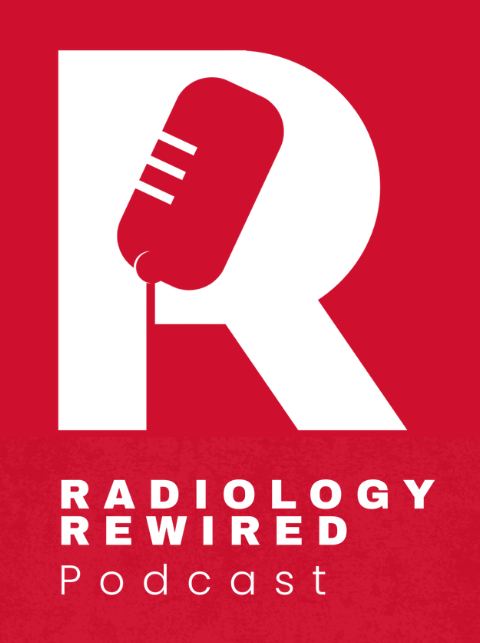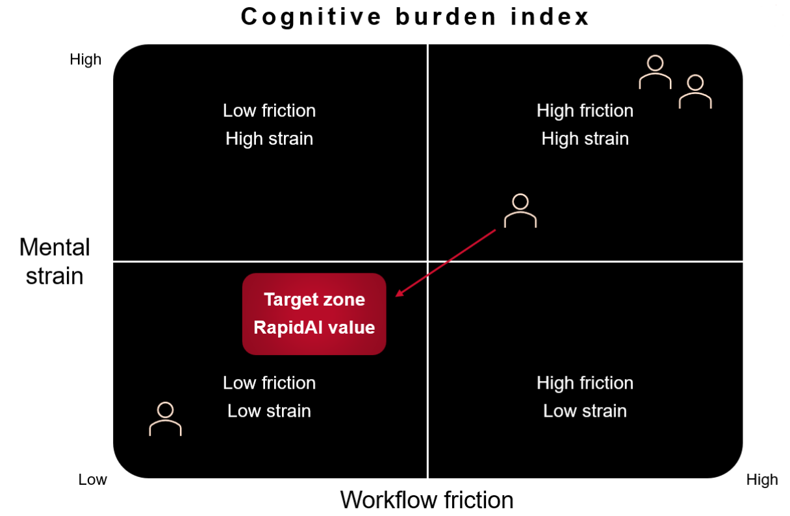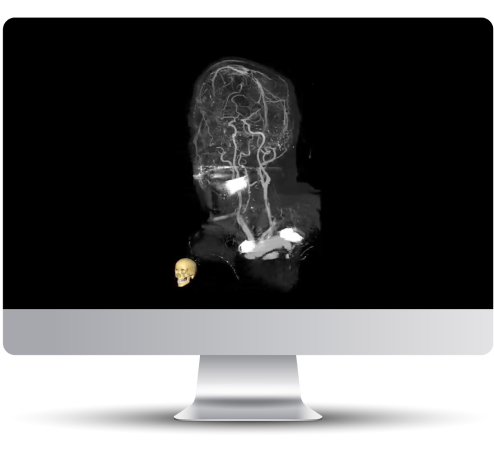Reviewed by Vivek Yedavalli, MD, Neuroradiologist at Johns Hopkins
For decades, the prevailing wisdom in stroke care has been simple: patients with a large ischemic core have little to gain from reperfusion therapies. Recently, however, new evidence has challenged this assumption. This article—reviewed by Dr. Vivek Yedavalli, MD, neuroradiologist at Johns Hopkins University—unpacks the trial findings and explains why determining treatment approaches may be more complex than once believed.
In this Q&A, we’ll uncover what the paradox means, why it matters, and how it could transform patient selection for thrombectomy.
What is meant by a “large core” in stroke?
A large core refers to the portion of brain tissue that has already sustained severe, irreversible ischemic injury. It’s typically defined using the following imaging markers:
Alberta Stroke Program Early CT Score (ASPECTS): A score of 0–5 (out of 10) is often considered a “large core” stroke.
Core volume thresholds: Many trials use ≥ 50 or 70–100 mL of infarct volume on CT perfusion (CTP) or MRI diffusion-weighted imaging (DWI) as a cutoff for large core categorization.
Traditionally, patients with such extensive damage were excluded from endovascular therapy (EVT) studies, under the assumption that there was little viable brain left to save. As noted by Dr. Yedavalli and colleagues, these imaging definitions continue to evolve as technology and evidence advance.
To learn more about care pathways, visit our page on ischemic stroke care.
Why was EVT traditionally withheld in large-core patients?
The rationale comes from the core/penumbra model. This widely accepted framework divides stoke-impacted brain tissue into:
- Ischemic Core: irreversibly damaged, non-salvageable tissue.
- Penumbra/Tissue at Risk: hypoperfused but still viable tissue that can recover if reperfused.
For a timeline view of how stroke treatment has advanced, see our stroke treatment timelines.
What do recent trials show about EVT in large-core strokes?
Surprisingly, six large RCTs—RESCUE-Japan LIMIT, ANGEL-ASPECT, SELECT2, TENSION, TESLA, and LASTE—all demonstrated that EVT provides benefit in patients with large-core infarcts.

Table summarizing six randomized trials evaluating EVT in large-core stroke. Displays ASPECTS imaging criteria, sample sizes, 90-day primary outcomes, and key safety or mortality notes. Highlighted studies (SELECT2 and ANGEL-ASPECT) demonstrated benefit extending to the late treatment window (up to 24 hours).
Across six randomized trials, five demonstrated significant benefit of EVT in patients with large-core infarcts, while one (TESLA) showed a positive trend that did not meet its primary endpoint. Collectively, these findings indicate that EVT can provide meaningful benefit even in patients with large-core infarcts, though outcomes remain poorer than in small-core cohorts. Importantly, benefits extended into the late treatment window (up to 24 hours) in SELECT2 and ANGEL-ASPECT, and safety signals were reassuring across all studies, with no significant increase in symptomatic intracranial hemorrhage.
The paradox study authors emphasize that while EVT offers measurable benefit, expectations must remain realistic given the poorer outcomes compared with small-core cohorts.
Why is this considered paradoxical?
Because the results appear to contradict the traditional core/penumbra model. If large cores truly represented “dead brain,” reperfusion should not help.
- Core estimates may not be fully accurate. Early edema and imaging artifacts can exaggerate infarct size (sometimes called a “ghost core”). Although this phenomenon tends to be seen in very early time windows such as the first 90 minutes since symptom onset.
- Large cores may not be homogeneous. Within the damaged region, there may be pockets of still-viable penumbra (“minipenumbras”). ASPECTS also has modest inter-reader agreement making it a suboptimal tool for evaluation of extent of ischemic core on noncontrast CT evaluation.
- Patient variability matters. Some individuals (so-called “slow progressors”) maintain more viable tissue for longer due to collateral circulation.
As highlighted by Dr. Vivek Yedavalli, MD, and colleagues in the Large-Core Paradox Stroke Review, these findings underscore the need to rethink how we define salvageable tissue.
RapidAI recently highlighted this shift in perspective in a LinkedIn post, underscoring how the large-core paradox is reshaping clinical thinking.
What mechanisms may explain the paradox?
1. Penumbra salvage still occursIt was a central theme in the review that over 90% of patients in some trials demonstrated perfusion mismatch, meaning salvageable penumbra was still present.
Recent work by Yedavalli et al. further supports this finding, showing that a substantial proportion of patients with large-core infarcts exhibit persistent penumbral tissue and may therefore benefit from reperfusion therapy (Yedavalli et al., Clinical Neuroradiology, 2024).
- EVT can reduce the development of vasogenic brain swelling, which is common in large core strokes and often fatal.
3. Imaging overestimation of irreversible damage
- CT and MRI thresholds are imperfect and are snapshots in time. In the early window, edema and hypoperfusion can make tissue appear unsalvageable when, in fact, some neurons may still recover after reperfusion.
- Advanced tools like Rapid CT Perfusion imaging and Rapid MR Perfusion imaging — both of which were used in the large-core RCTs, can help clinicians distinguish true core from salvageable tissue more clearly. This same perfusion-based selection was pivotal in DAWN and DEFUSE 3, which extended treatment eligibility out to 24 hours from last known well.
What are the clinical implications for patient selection?
These findings could reshape stroke triage:
- Do not automatically exclude large-core patients, triage is still necessary. If imaging shows a large infarct but the patient is otherwise a candidate for EVT, treatment should be considered.
- Refine imaging-based selection. Tools like automated ASPECTS scoring and advanced perfusion analysis may better distinguish true core from salvageable tissue.
-
Balance expectations. While outcomes are generally poorer than in small-core patients, even modest gains—such as regaining ambulation—are meaningful for patients and families.
How can AI-enabled imaging help in the large-core paradox?
The paradox highlights the need for more accurate, real-time decision support. RapidAI tools such as:
- Automated perfusion analysis to identify residual penumbra and quantify collaterals.
- AI-driven ASPECTS scoring to reduce human subjectivity in core estimation.
- Lumina 3D automated CTA reconstructions to more quickly and clearly visualize the vasculature
- Edge Cloud Platform to deliver scalable, secure AI decision support.
These capabilities can support clinicians in identifying patients who may still benefit from EVT, even when imaging suggests a “large core.”
From paradox to practice: what comes next
The large-core paradox challenges long-held beliefs in stroke care. While patients with extensive infarcts have poorer outcomes overall, EVT can offer a real and measurable benefit compared to medical therapy alone.
By refining imaging, leveraging AI, and maintaining an open mind about treatment eligibility with advanced prognostication, clinicians can extend the benefits of thrombectomy to a broader group of patients—potentially improving survival and function where once there was little hope. For additional insights, explore our stroke AI insights hub.


